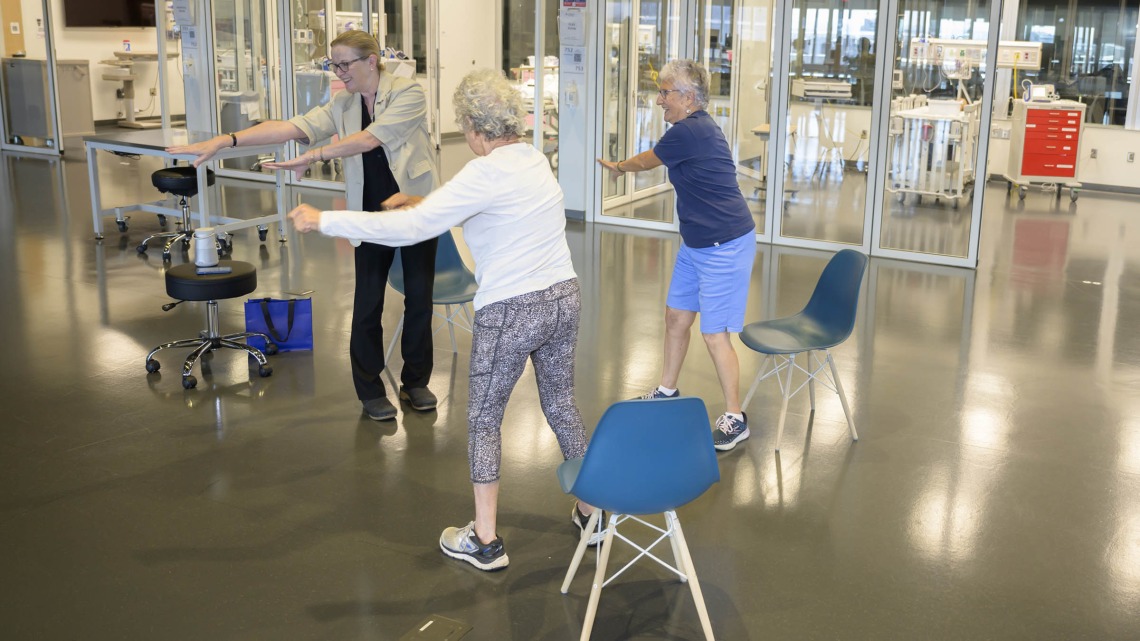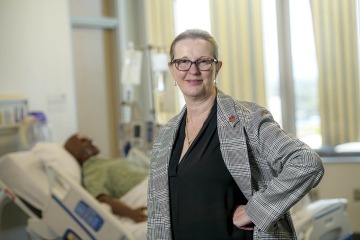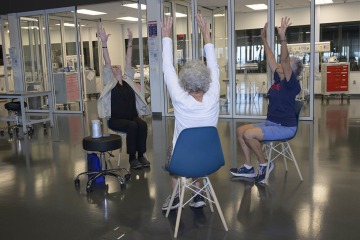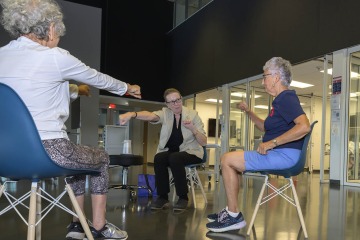Making moves in the field of geriatric physical therapy
Christine Childers draws from her past as a dance teacher in her research as she helps shape the future of physical therapy for an aging population.

Christine Childers draws from her past as a dance teacher in her research as she helps shape the future of physical therapy for an aging population.
Christine Childers, PT, PhD, did all she could to comfort her father as he dealt with Parkinson’s disease in the final phase of his life. As Childers watched him slip away, she began to consider a new career path – one that would lead her to become a geriatric physical therapist.

As a physical therapist specializing in geriatrics, Christine Childers, PT, PhD, wants to help older adults maintain their health and well-being. As an educator, she is passionate about training the next generation of physical therapists to care for an aging population.
“I wanted some way to help him, to make his life better,” Childers said. “That drew me to geriatric physical therapy, just thinking of ways I could help older adults heal and build their strength.”
Since then, she has become a leading voice in the geriatric physical therapy field and helped countless older adults rehabilitate from injuries and chronic conditions. Now, as founding director of the University of Arizona College of Health Sciences’ Doctor of Physical Therapy program, she is empowering a new generation of therapists to do the same.
From the shadows to the spotlight
In 1969, Kansas City, Missouri, physical therapist Joan Mills established the American Physical Therapy Association’s first Section on Geriatrics to give targeted care to older patients in a 200-bed general hospital that previously gave uniform care to patients regardless of age.
Geriatric physical therapy was deemed a specialization in physical therapy in 1989, and the first geriatric clinical specialist examination was in 1992. The number of geriatric specialists skyrocketed from 14 in 1992 to 1,109 in 2010, and as of June 2023, there were 4,112. Childers is among that group.

Childers emphasizes movement and mobility when working with patients. She uses her past as a dance teacher to help people improve their range of motion and increase physical activity.
Physical therapy’s geriatric specialty is dedicated to helping people 65 and older cope with the unique situations that come with aging, with the overall goal of maintaining excellent health and well-being. Therapists focus on bone health, mobility and joint pain while caring for patients with conditions that tend to accompany advanced age, such as arthritis. Customized treatment plans might include physical activities, stretching, functional movements and hands-on therapy.
A trained dance teacher, Childers emphasizes the connection between the moving body and active mind. She takes pleasure in busting myths about older adults, such as that they’re fragile or weak. Their longevity alone proves them to be among the toughest people around. Because of that, Childers believes it’s important to push older patients to their physical limits.
“Pushing them hard enough to get results is a skill, and that’s something that we have to help with,” Childers said. “They need our help to push them into a place they need to get to in order for the therapy to work.”
When working with patients, Childers emphasizes the importance of breaking away from a sedentary lifestyle. She teaches that movement and mental engagement are key to maintaining mental and physical health. Injecting activity into typically passive activities, such as marching or jogging in place while watching TV or doing crossword puzzles during commercial breaks, can keep the mind and body sharp.
“People are living longer now, and we want to make sure they’re living better.”
—Christine Childers, PT, PhD
“Commonplace things like doing laundry, going to check the mail and getting your own glass of water can mean the difference between taking a few thousand steps a day or less than 500,” Childers said. “Children of older adults are trying to protect their parents when they do things like that for them, but they’re really just putting them in more danger.”
Filling a local need
Childers started her medical career as a physiotherapist, then managed inpatient rehabilitation settings, gaining a board certification in geriatrics. Her passion for helping older adults led her to complete a master’s in gerontology in May 2006 and a doctorate in health psychology in 2018.
She has served on the Federation of State Boards of Physical Therapy as a member of the exam development committee, and she conducts site visits for candidacy and re-accreditation on behalf of the Commission on Accreditation in Physical Therapy Education. She also is director of the Advanced Competency in Home Health certification for the Home Health Academy of the American Physical Therapy Association.
As part of the American Board of Physical Therapy Specialties Geriatric Specialty Council, she conducted an analysis of practice and suggested revisions to the geriatric physical therapy specialty practice. The research was published in the Journal of Geriatric Physical Therapy.

Childers sees patients regularly and often integrates her experiences with patients into her lesson plans for students.
“We looked at what are we seeing now that should be considered specialist practice. We deleted some things, not because we said that clinicians aren’t doing it, but because every clinician should be doing these things and not just geriatric specialists,” said Childers, who continues to see patients clinically while also teaching and conducting research that shapes the future of the field. “We added in new areas that would apply to the changing landscape we’ve seen develop over the past 10 years. We’re seeing a lot more frailty; we see more obesity; we’re seeing more sedentary behavior and comorbidities, things like that.”
Compared with national averages, Arizona has fewer physical therapists per capita and a higher population of people age 65 and over. Childers says local clinicians tell her there is a severe lack of physical therapists in the region and a particular need for those with advanced certifications in geriatrics, as well as cardiopulmonary and neurology.
The College of Health Sciences’ Doctor of Physical Therapy program, which is currently seeking accreditation, is designed to help stem those shortages. Childers says the new program will create an expanded pipeline of skilled professional physical therapists to boost care for patients in the state.
As Childers works every day to build the Doctor of Physical Therapy program, she envisions a future in which its graduates are working throughout Arizona to give everyone including more older adults the physical therapy they need to find strength and fulfillment as they age.
“We want to fill the gaps. As a land grant university, we want to give back to the community,” Childers said. “People are living longer now, and we want to make sure they’re living better. Whether they’re recovering from a stroke or have a Parkinson’s diagnosis, we can work with them to make sure they live the best quality of life possible.”
Related Stories
Our Experts
Christine Childers, PT, PhD
Founding Director, Doctor of Physical Therapy program, College of Health Sciences
Associate Professor, Department of Orthopaedic Surgery, College of Medicine – Tucson
Contact
Phil Villarreal
Office of Communications, University of Arizona Health Sciences
520-403-1986, pvillarreal@arizona.edu

